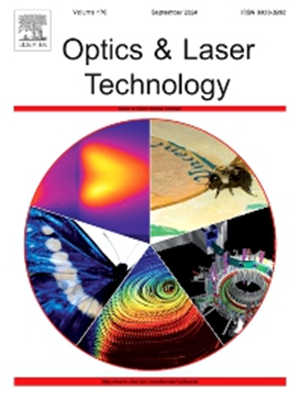利用单目视觉对机器人装配中的 3C 薄部件进行高精度 6-D 姿态测量的方法
IF 5
2区 物理与天体物理
Q1 OPTICS
引用次数: 0
摘要
3C 薄部件的 6-D 姿态测量对于机器人装配中的对准过程至关重要。由于厚度较薄,两个表面的特征耦合在一起,在图像中难以分辨,导致姿态测量的精度降低。本研究提出了一种基于单目视觉的 6-D 姿态测量方法。研究提出了一种名为 "双表面轮廓投影误差优化(DSRCEO)"的算法,通过同时优化两个表面的特征来提高姿态测量的精度。在 DSRCEO 中,首先构建计算域和图像域,然后通过综合考虑两个域得出 DSRCE 误差指数,以评估当前姿态估计的质量。通过最小化 DSRCE,对 6-D 姿态的初始估计进行迭代优化,从而不断提高测量精度。DSRCEO 框架适用于各种形状的薄部件,并推导出两种最常见形状(修剪圆和多边形)的具体算法实现。最后,通过充分的模拟和实验验证了所提算法的准确性和适用性。本文章由计算机程序翻译,如有差异,请以英文原文为准。
High-accuracy 6-D pose measurement method for 3C thin parts in robotic assembly by monocular vision
The 6-D pose measurement of the 3C thin parts is essential for alignment process in robotic assembly. Due to the thin thickness, features from two surfaces are coupled together and difficult to distinguish in the image, causing the decrease in the accuracy of the pose measurement. In this study, a 6-D pose measurement method based on the monocular vision is proposed. An algorithm named dual-surface reprojection contour error optimization (DSRCEO) is proposed to simultaneously optimize the features from both two surfaces to improve the accuracy of pose measurement. In the DSRCEO, the computational domain and the image domain are constructed, and then an error index of DSRCE is derived by comprehensive consideration of the two domains to evaluate the quality of the current pose estimation. By minimizing the DSRCE, the initial estimation of the 6-D pose is iteratively optimized to continuously improve the measurement accuracy. The framework of the DSRCEO is available for the thin parts with various shapes, and specific algorithm implementations for the two most common shapes (trimmed circle and polygon) are derived. Finally, the accuracy and applicability of the proposed algorithm are verified through both sufficient simulation and experiments.
求助全文
通过发布文献求助,成功后即可免费获取论文全文。
去求助
来源期刊
CiteScore
8.50
自引率
10.00%
发文量
1060
审稿时长
3.4 months
期刊介绍:
Optics & Laser Technology aims to provide a vehicle for the publication of a broad range of high quality research and review papers in those fields of scientific and engineering research appertaining to the development and application of the technology of optics and lasers. Papers describing original work in these areas are submitted to rigorous refereeing prior to acceptance for publication.
The scope of Optics & Laser Technology encompasses, but is not restricted to, the following areas:
•development in all types of lasers
•developments in optoelectronic devices and photonics
•developments in new photonics and optical concepts
•developments in conventional optics, optical instruments and components
•techniques of optical metrology, including interferometry and optical fibre sensors
•LIDAR and other non-contact optical measurement techniques, including optical methods in heat and fluid flow
•applications of lasers to materials processing, optical NDT display (including holography) and optical communication
•research and development in the field of laser safety including studies of hazards resulting from the applications of lasers (laser safety, hazards of laser fume)
•developments in optical computing and optical information processing
•developments in new optical materials
•developments in new optical characterization methods and techniques
•developments in quantum optics
•developments in light assisted micro and nanofabrication methods and techniques
•developments in nanophotonics and biophotonics
•developments in imaging processing and systems

 求助内容:
求助内容: 应助结果提醒方式:
应助结果提醒方式:


